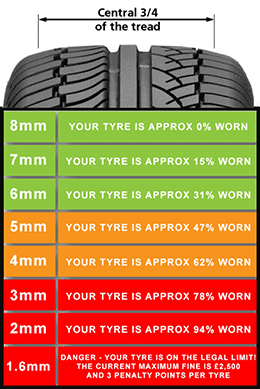Tyre Tread Depth and Safety Checks
Updated 04/08/2024
One of the most important checks you can make on your car is the tyre tread depth.
Having worn tyres means the only contact patch between you and the road is past its best. You could almost call it an accident waiting to happen.
If the safety risks don’t hit home, maybe the risk of a £2,500 fine and three penalty points for a worn tyre will? That’s per tyre, too. If all four tyres are worn below the legal limit, you could potentially lose your licence and face a £10,000 fine.
What is the legal tyre tread depth?
The law states the minimum legal tyre tread depth for cars in the UK and Europe is 1.6mm across the central three-quarters of the tyre. The tread must meet this minimum requirement across its complete circumference.
But this is just the legal minimum. Tyre and safety experts believe the 1.6mm legal minimum is insufficient to guarantee safety – most recommend a minimum tread depth of 3mm for tyre replacement. Tests by UK technical organisation MIRA found that, once tyres are below 3mm, stopping distances increase dramatically.
The difference in wet braking distance between a tyre worn to 3mm and one worn to 1.6mm can be as much as 44%.
Worn tyres are particularly dangerous in the wet because a tyre’s tread helps disperse water away from the contact patch between tyre and road. If there’s less tread depth, less water can be shifted, increasing the risk of aquaplaning and losing grip.
In heavy rain, each tyre can shift one gallon of water every second, illustrating just how hard tyres work. Simply put, deeper tread means they can work better, improving grip.
How to check tyres are in a roadworthy condition
20p tyre tread depth test
The 20p test is a simple, quick and easy way of checking the tyre tread of your car's wheels. Just take a 20p coin and insert it into the tread grooves on the tyre. If you can't see the outer band on the coin, your tyres are above the legal limit.
However, if you can see the band and that section of the coin is still visible, your tyres could be unsafe and require professional inspection by a mechanic. Drivers should conduct the 20p test every month to check tyre tread depth.
Read the tyre tread wear indicators
Tread depth indicators, also known as wear bars, are small raised sections found within the tread grooves of a tire. To use them, visually inspect the tire and locate these bars. If the tread surface has worn down to the level of the indicators, it means the tire tread is at or below the minimum legal limit and needs to be replaced.
Using a tyre tread depth gauge
A tire tread gauge typically looks like a small, pen-sized tool with a sliding ruler or digital readout. To use it, press the base of the gauge flat against the tire surface and insert the probe into the tread groove. Push the gauge down until the base touches the tire, then read the measurement from the ruler or display to determine the tread depth.
What happens if you have an accident on illegal/bald tyres?
Driving with tyres that have a tread below the legal limit - or even worse, are bald - is dangerous. It can put you and other motorists at risk.
If you are involved in an accident and the car you are driving has illegal or bald tyres, you should be aware of the consequences.
Any insurance claim as a result of an accident could be invalidated, so potentially your insurer won't pay out any money any repairs needed to your vehicle.
Moreover, driving with dangerous or defective tyres also puts drivers at risk of a fine of up to £2,500 and three points on their license. That is per tyre, so four illegal tyres could mean a fine of £10,000 and 12 penalty points.
Source and credit www.rac.co.uk

